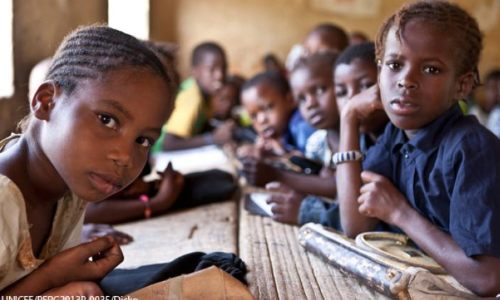GENEVA/NEW YORK, Aug 28 (NNI): For the first time, the United Nations Committee on the Rights of the Child has explicitly affirmed the children’s right to a clean, healthy and sustainable environment, issuing comprehensive interpretation of Member States’ obligations under the UN Convention on the Rights of the Child.
This Convention, created in 1989 and ratified by 196 states, outlines universal children’s rights such as the right to life, survival and development, and the right to health. A General Comment provides legal guidance on what these rights imply for a specific topic or area of legislation.
The now published “General Comment No. 26 on children’s rights and the environment with a special focus on climate change”, explicitly addresses the climate emergency, the collapse of biodiversity and pervasive pollution, outlining countermeasures to protect the lives and life perspectives of children. Philip Jaffé, member of the United Nations Committee on the Rights of the Child states:
“Children worldwide have been leading the fight against climate change; calling on their governments and corporations to take action to protect the planet and their future. With its General Comment No. 26, the Committee on the Rights of the Child not only echoes and amplifies children’s voices, but also clearly defines the rights of children in relation to the environment that States Parties should respect, protect and fulfil… collectively and urgently!”
“This new General Comment marks a vital step forward in the recognition that every child on Earth has the right to live in a clean, healthy and sustainable environment. Governments must now take urgent action to address the global environmental crisis in order to breathe life into these inspiring words,” says David Boyd, UN Special Rapporteur on Human Rights and the Environment.
General Comment No. 26 specifies that States are responsible not only for protecting children’s rights from immediate harm, but also for foreseeable violations of their rights in the future due to States’ acts — or failure to act — today. Furthermore, it underlines that States can be held accountable not only for environmental harm occurring within their borders, but also for the harmful impacts of environmental damage and climate change beyond their borders. Particular attention is to be paid to disproportionate harm faced by children in disadvantaged situations.
The 196 States that have ratified the Convention on the Rights of the Child are urged to take immediate action including organizing the phase out of coal, oil and natural gas and shifting to renewable energy sources, improving air quality and ensuring access to clean water, transforming industrial agriculture and fisheries to produce healthy and sustainable food, and protecting biodiversity.
The guidance states that children’s views must be considered in environmental decision-making and stresses the critical role of environmental education in preparing children to take action, advocate, and protect themselves from environmental harm. General Comment No. 26 itself is the outcome of global and intergenerational engagement, including broad consultation with Member States, international and regional organizations, such as United Nations entities and specialized bodies, national human rights institutions, civil society organizations and children themselves.
Joshua Hofert, Executive Director of Terre des Hommes Germany, states: “Children are the least responsible for the climate crisis but suffer most from its consequences: every year 1.7 million children under the age of five lose their lives due to avoidable environmental damage. And yet, children and young people are under-represented in virtually all decision-making processes on environmental policy. With General Comment No. 26, we have tried to change this: with more than 16,000 contributions from children across 121 countries, this has been one of the most inclusive child participation processes at UN level to date. As Terre des Hommes, we are proud to have coordinated this extraordinary General Comment process with the UN Committee on the Rights of the Child.”
Terre des Hommes — the Committee’s official partner for the development of General Comment No. 26 — led a process with multi-level stakeholders, significantly involving and engaging children through online consultations to inform the shape and substance of the text. The international child rights organization coordinated a global Advisory Board of experts and a team of 12 child advisors aged 11 – 17 to support the Committee. The United Nations Children’s Fund (UNICEF), as a member of the Advisory Board, provided further technical expertise and helped collect views from children around the world as part of the consultation process.
One of the child advisors, Āniva, a 17-year-old climate and child rights activist from the Pacific Islands, comments: “To me, the General Comment means worldwide change that is necessary as we move forward in fighting environmental issues and take global action in protecting our planet for our generation and the generations to come. It gives children a stronger basis in international law to enforce our Rights to a Healthy Environment. Globally, we are seeing more action for people to protect the environment through Human Rights and GC26 forms an important part of this.”
General Comment No. 26 assists in interpreting States’ commitment under the Paris Agreement to respect, promote and consider their child rights obligations when taking action to address climate change. It also makes it clear that child rights impact assessments must be undertaken for all environment-related legislation, policies and projects, regulations, budget or other decisions. States will have to report periodically to the UN Committee on relevant progress they have made in protecting children’s environmental rights.
“Climate financing and policy decisions continue to neglect the needs of children,” said Paloma Escudero, UNICEF Special Adviser on Advocacy for Child Rights and Climate Action. “This must change. The General Comment is an urgent call for countries to prioritize action in every aspect of childhood impacted by climate change, such as a child’s right to education, to safe water and a healthy environment. The climate crisis is a child rights crisis. Every government has an obligation to protect the rights of every child in every corner of the planet, especially those boys and girls living in countries that have contributed least to this problem but are enduring the most dangerous floods, droughts, storms and heat.” NNI








































